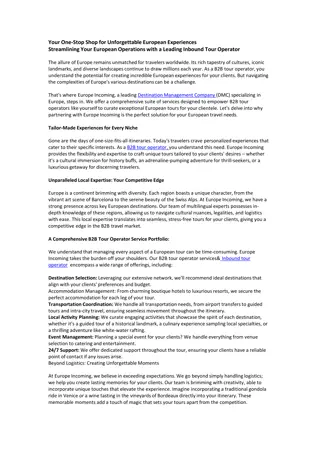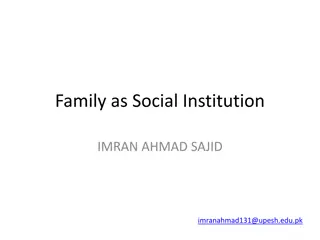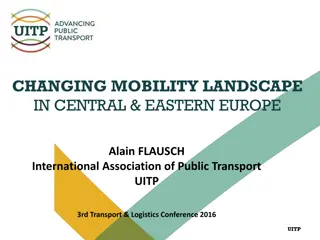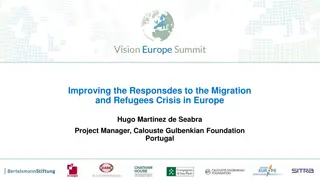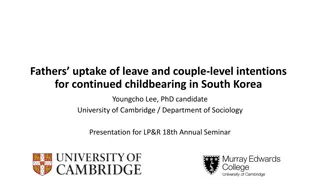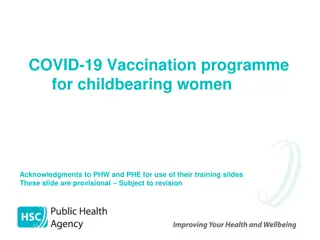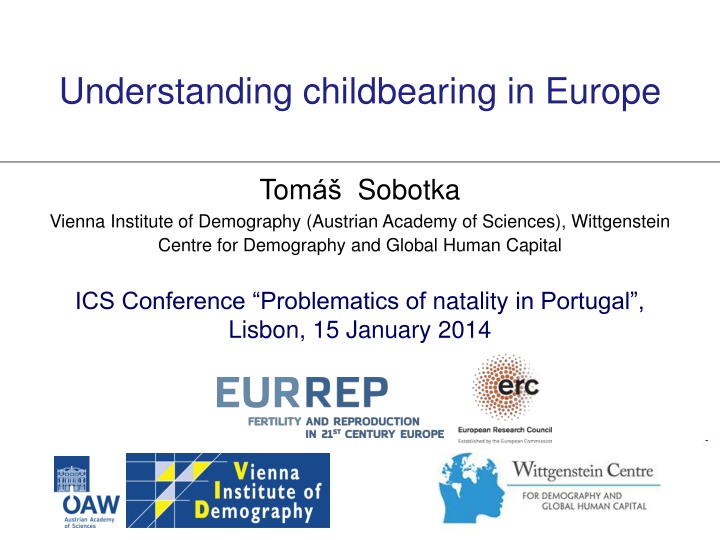
Insights into European Fertility Trends and Policy Debates
Explore the dynamics of childbearing in Europe post-1990, including shifts in fertility rates, impacts of economic uncertainty, and policy responses to low birth rates. The presentation discusses delayed childbearing, the Great Recession's influence on fertility, and government initiatives to address declining birth rates, with a focus on Portugal in a Southern European context.
Download Presentation

Please find below an Image/Link to download the presentation.
The content on the website is provided AS IS for your information and personal use only. It may not be sold, licensed, or shared on other websites without obtaining consent from the author. If you encounter any issues during the download, it is possible that the publisher has removed the file from their server.
You are allowed to download the files provided on this website for personal or commercial use, subject to the condition that they are used lawfully. All files are the property of their respective owners.
The content on the website is provided AS IS for your information and personal use only. It may not be sold, licensed, or shared on other websites without obtaining consent from the author.
E N D
Presentation Transcript
Understanding childbearing in Europe Tom Sobotka Vienna Institute of Demography (Austrian Academy of Sciences), Wittgenstein Centre for Demography and Global Human Capital ICS Conference Problematics of natality in Portugal , Lisbon, 15 January 2014
European fertility ups and downs Distinct period waves in European fertility after 1990 The 1990s: Fertility declines to record-low levels 2000s: Fertility reversal, increasing period TFRs (ex. In PT) After 2008: Mostly declining fertility after the onset of the recession, especially in Southern Europe Shift towards later childbearing: strong influence on fertility trends Economic uncertainty closely linked to fertility Interrelated changes in values, family, gender relations, education Worries about too low birth rates, diverse policy responses The return of pro-natalism in policy debates Jacques Chirac (1984): In demographic term, Europe is vanishing. Twenty years or so from now, our countries will be empty (Teitelbaum, 2000). Pritchett and Viarengo (2012: 55): Large parts of Europe committing gradual demographic suicide
Agenda European fertility trends and the shift to delayed childbearing The Great Recession and fertility Reproductive preferences Government responses to low fertility & policy debates Discussion: Low fertility in Portugal in a (Southern) European context Data: Eurostat, Human Fertility Database, national statistical offices, VID, own computations, surveys (GGS, FFS, EVS, other) Regions: following main geographic, cultural, economic, welfare and demographic divisions - Western, Northern (Nordic), Southern Europe, German-speaking countries - Central, South-eastern, Eastern Europe (EU regions in blue, except NO, ICE, CH)
European fertility trends and the shift to delayed childbearing
Period Total Fertility: North & West vs. South & Centre & East? Source: own elaboration based on European Demographic Data Sheet 2014 (VID 2014), Eurostat and National Statistical Offices Data
Period Total Fertility: Parallel trends in Portugal and Spain Source: own elaboration based on European Demographic Data Sheet 2014 (VID 2014), Eurostat and National Statistical Offices Data
The shift to a later childbearing: Mean age at first birth in selected countries 32 Western & Northern Europe Spain Central Europe Eastern Europe United States Portugal 30 28 Mean age at first birth 26 Portugal 24 22 20 1970 1975 1980 1985 1990 1995 2000 2005 2010 Source: Sobotka 2013; computations from the Human Fertility Database, Eurostat and data from national statistical offices
The postponement transition: Key driving factors and consequences Key driving factors: Expansion of university education, especially among women Enrollment in education not compatible with parenthood Women with tertiary education aged 30-34 in Portugal: 13% in 2001-> 31% in 2011 (OECD Education at a Glance 2014) Economic uncertainty: unemployment, job instability, low wages Particularly prominent in Southern and Eastern Europe Unaffordable housing, limited rental market Efficient contraception, available abortion and morning after pill Delayed partnership formation Changed family values and preferences; higher acceptance of childlessness, preference for non-family lifestyles
Why does delayed childbearing affect period fertility? The tempo effect : Shifting age at childbearing the most important factor influencing short-term shifts in period total fertility rate (TFR) in Europe Also explaining extreme low TFR levels (<1.3) (Sobotka 2004, Goldstein et al. 2009) Why? Births postponed in 2010 are simply not realised in that year This may not affect generation s (cohort) fertility rate However, late age at childbearing also increases the risk of infertility and of not realising the delayed birth later in life Demographic analysis: Two ways to address tempo effects 1) Computing alternative fertility indicators aiming to control for it 2) Looking at the real (completed) fertility of women aged over 40
Fertility in selected European countries, 2009-11: conventional and tempo-adjusted TFR 2.40 2.24 2.19 TFR 2010 2.14 2.20 adjusted TFRp* (2009-11) 2.02 1.99 1.99 1.93 1.92 1.90 2.00 1.80 1.79 1.80 1.66 1.66 1.62 1.60 1.60 1.54 1.53 1.60 1.39 1.39 1.38 1.37 1.40 1.20 1.00 Data Source: European Demographic Data Sheet 2014 (VID 2014)
Cohort fertility trends and variation Considerably higher completed fertility (CTFR) than the period TFR In most countries, a stabilisation or slight increases projected in the 1970s cohorts (Myrskyl et al. 2013, Prioux et al. 2013, European Demographic Data Sheet 2014) Earlier cohort fertility decline in Europe overshadowed by falling family size in East Asia Expected European CTFR range, 1975 cohort: 1.4 in Spain, 1.46 in Italy vs. 2.1 in Ireland, 2.04 in Norway and 2.02 in France Portugal: shifting from a higher-ranking fertility to one of the lowest- fertility countries in Europe Trend Portugal, alongside Spain, resembles a fast fertility fall in East Asia
Cohort fertility trends and variation Observed and projected completed cohort fertility in selected regions in Europe, East Asia and in the United States, women born 1960-79 2.20 Cohort fertility (children per woman) 2.00 1960 1.80 1970 1.60 1979 1.40 1.20 1.00 Nordic countries Western Europe Central & Eastern Europe Germany, Austria, Switzerland Southern Europe Portugal United States East Asia Myrskyl , M., J. Goldstein, and Y. Alice Cheng. 2013. New Cohort Fertility Forecasts for the Developed World: Rises, Falls, and Reversals. Popul. Dev. Rev. 39 (1): 31 56
Contrasting patterns of family building, selected countries Number of children ever born, female birth cohorts ca. 1968 Share of women with 2 children 3+ children CTFR 14.6 42.2 14 38 19.5 53.6 Completed fertility at 1.80 or higher Country Higher, 2 or 3 children model Higher, polarised Higher, 2-child model, low childlessness Czech Republic Completed fertility below 1.70 Low, 1-child model Low, polarised Low, few large families model No children 1 child 11.6 20 7.9 Norway England & Wales 31.7 28 19.0 2.04 1.91 1.89 Russia Austria Spain 7.9 21.5 16.8 39.4 38.0 44.1 12.5 17.8 11.0 1.62 1.59 1.52 40.2 22.8 28.1 no systematic difference in childlessness between the countries with higher and lower completed fertility Data based on Human Fertility Database and ONS (for England and Wales).
COMMON PRECONDITIONS FOR FAMILY FORMATION in contemporary Europe Completing education Achieving relatively stable employment Accumulating resources (including sufficient housing) (Own housing: especially Southern Europe) Having a stable partner (marriage no longer necessary) Feeling ready for parenthood Not only support for families, but also living conditions and choices of young adults in pre-family stage matter >2008: Economic position of young adults deteriorating rapidly in most countries; potentially negative effects on family formation and fertility
The economic recession in Europe Main pathways how the recession affected partnership formation and fertility Unemployment, employment instability: loss of resources, inability to accumulate resources, uncertainty about future, inability to make binding long- term decisions Frozen housing market, construction & mortgage lending Government cuts, also in social and family-related spending often affect especially the young Stronger enrollment in university education & later home leaving? Wasted generation? EU-27: 14% young adults (age 18-24) NEETs; (Not in Employment, Education or Training) in 2013; rapid increase across Southern Europe to 29% in IT+GR, 24% in ESP, 19% in PT Strong effect of economic instability identified for first births and partnership formation (also indirect effect on first births); especially for men (Adsera 2005, 2009, 2011; Pailhe 2009; Neels et al 2012; Schmitt 2012; Sobotka et al. 2011)
Trends in the period Total Fertility Rate (TFR), 2000-2013 (Southern Europe, EU, France) Pre-recession: 2000-2008 2.20 France 2.00 EU Italy 1.80 Greece Portugal Spain 1.60 1.40 1.20 1.00 2000 2002 2004 2006 2008 Source: Own computations based on Eurostat 2014 and national statistical offices data
Trends in the period Total Fertility Rate (TFR), 2000-2013 (Southern Europe, EU, France) 2.20 2.00 1.80 France EU Italy 1.60 Greece Portugal 1.40 Spain 1.20 1.00 2000 2002 2004 2006 2008 2010 2012
Which countries most affected? Multiple effects of the recession (changes 2007-12) OECD countries GDP (<-3%) x x x x x x x x x UNEMPL. (>+5%) EMPLOYMENT HH INCOME NEETS young WORKLESS HH Buying FOOD (<-3% or more) (<-3%) (>15%) x x x x x x x x x x x x x x x x x x x x x TOTAL SCORE 7 7 6 6 5 4 4 4 3 2 2 1 4 (>2%) x x x x x (>+3%) x x x x x x x x Greece Ireland Italy Spain Portugal Hungary Estonia Slovenia Iceland Slovakia Denmark Finland USA x x x x x x x x x x x x Outside OECD: Bulgaria, Latvia, Lithuania, Romania, Ukraine most affected
Which countries most affected? Multiple effects of the recession (changes 2007-12) OECD countries GDP (<-3%) x x x x x x x x x UNEMPL. (>+5%) EMPLOYMENT HH INCOME NEETS young WORKLESS HH Buying FOOD (<-3% or more) (<-3%) (>15%) x x x x x x x x x x x x x x x x x x x x x x x TOTAL SCORE 7 7 6 6 5 4 4 4 3 2 2 4 (>2%) x x x x x (>+3%) x x x x x x x x Greece Ireland Italy Spain Portugal Hungary Estonia Slovenia Iceland Slovakia Denmark USA Economically most stressed x x x x x Economically stressed x x x x Outside OECD: Bulgaria, Latvia, Lithuania, Romania, Ukraine most affected
Declines in period TFR between 2008 and 2012 Greece US Spain Denmark Portugal OECD: 5 economically most stressed OECD: 4 economically stressed + US OECD: 12 other Slovenia European Union Russia -15.0 -10.0 -5.0 Change in period TFR 2008-12 (%) 0.0 5.0 10.0 15.0
Age schedule of childbearing: stronger declines among young adults Changes in fertility rates by age, 2008-12: EU, Portugal, and 5 economically most stressed countries 50 EU 40 Economically most stressed 30 Portugal % change in fertility rate 20 10 0 -10 -20 -30 -40 SOURCE: Own computations based on Eurostat database (2014) 2008-12 -50 15 20 25 30 35 40 Age
Age schedule of childbearing: stronger declines among young adults Changes in fertility rates by age, pre-recession (2004-2008) compared with the recession (2008-12) period 50 50 EU EU 40 40 Economically most stressed Economically most stressed 30 30 Portugal Portugal % change in fertility rate % change in fertility rate 20 20 10 10 0 0 -10 -10 -20 -20 -30 -30 -40 -40 2008-12 2004-2008 -50 -50 15 20 25 30 35 40 15 20 25 30 35 40 Age Age
First births most affected except in Southern Europe Changes in fertility rates by birth order, in % (2008-12) 2.0 0.0 Percent decline in fertility rates -2.0 -4.0 -6.0 1st births -8.0 2nd births -10.0 3rd births -12.0 -14.0 -16.0 25 countries Southern Europe (GRE, ESP, PT) Portugal
Reproductive preferences (a joint research with Eva Beaujouan (VID))
Fertility intentions and ideals in Europe Remarkable lack of variation, two-child family norm almost universal Also no systematic variation by social status, very little difference between men and women 3.00 Mean intended family size of men and women aged 25-29, selected European countries, 1990s (FFS survey) and 2000s (GGS survey) Mean intended family size (Women) 2.50 2.00 1.50 Mean, women FFS surveys (1990s) GGS surveys (2000s) 1990s (15 countries): 2.18 1.00 1.00 1.50 2.00 2.50 3.00 2000s (10 countries): 2.16 Mean intended family size (Men)
Fertility intentions and ideals in Portugal Mean intended family size of women aged 25-29 in 10 European countries in 2000s (GGS survey): 2.16 Portugal, 2013, women aged 18-29 Mean desired family size: 2.20 Mean expected family size: 1.94 (Source: Inqu rito Fecundidade 2013, INE 2014, Figure 2.9)
A convergence in two-child family size ideal in Europe? Share of women aged 15-49 stating that an ideal family size is two (%); Summary of different surveys across Europe 80 Portugal Maximum Share of respondents with a two-child ideal (%) 70 75% (upper quartile) 60 Mean 50 25% (Lower quartile) 40 Minimum 30 SOURCE: Sobotka, T. and . Beaujouan. 2014. Two is best? The persistence of a two-child family ideal in Europe. Population and Development Review 40(3): 391-419. 20 10 0
Portugal: Increasing small family size ideal? Ideal family size in Portugal and Spain, 1981-2011; women aged 15-49 (different surveys) Portugal Spain 80 3.5 80 3.5 70 70 Ideal of2 children (%) 3.0 3.0 Percent with a given ideal Percent with a given ideal Mean ideal family size Mean ideal family size 60 60 2.5 2.5 Mean Ideal Family Size 50 50 2.0 2.0 40 40 Ideal of3+ children (%) 1.5 1.5 30 30 1.0 1.0 20 20 Ideal of1 or no children (%) 0.5 0.5 10 10 0 0.0 0 0.0 1990 EVS 2001 EB 2006 EB 2011 EB 1981 EVS 1990 EVS 1994 ISP 1995 EVS 2000 WVS 2001 EB 2006 EB 2011 EB Source: Sobotka & Beaujouan 2014
Government responses to low fertility & policy debates Source: somatosphere.net
Family policy agenda in Europe 1990s and 2000s: Strong interest of governments in family policies and potential effects of policies on birth rates Also clear from the regular UN survey on government views Increased spending in most OECD countries European Commission 2005: return to demographic growth one of three essential priorities EU: policies aiming to support combination of employment and family life and realisation of reproductive desires Also promoting gender equality Explicit policy goals (e.g., public childcare coverage for children below age 3) Eastern Europe: explicitly pro-natalist policies, also linked to conservative agenda and nationalistic ideology 2008: cuts in government spending on families in some countries
Many governments think fertility is too low Government view on fertility level and government policy on fertility in 22 countries ever reaching a period total fertility rate of 1.40 or below 22 Number of countries with a given view 20 18 16 14 12 10 8 Fertility too low 6 4 Policy to raise fertility 2 0 1996 2001 2003 2005 2007 2009 2011 Source: UN reports, UN World Population Policy Database; http://esa.un.org/PopPolicy/about_database.aspx
Public family policy discussions: different ideological underpinning (stylised versions) The gender equality or feminist discourse Gender inequality seen as an unfair obstacle for women, but also to fam. life and fertility (accentuated by Green + Soc. Dem. Parties) Policies improving early childcare provision, employment of women, equal pay, equal opportunities, and stronger involvement of fathers (including dedicated paternity & parental leaves) The conservative discourse Family instability and pressure on women to engage with career often seen as reasons for low fertility Policies supporting marriage and married families with children The traditional, nationalistic, or anti-establishment discourse Low birth rates seen as a threat to the long-term survival of the nation; usually concerned with the dominant ethnic group, often anti-migrant. Explicitly pronatalist policies, often targeting 2nd or 3rd births
Public family policy discussions: different ideological underpinning (2) The equalization (socialist/left) discourse Lack of resources (incl. housing) and income inequalities seen as the main obstacles to starting or enlarging a family Promoting redistribution through taxes and benefits The liberal discourse Perceived need to broaden the choices and options of different population groups Promoting more work and lifestyle flexibility (part-time, flexible jobs, but also childcare availability), supporting non-traditional families (gay/lesbian couples, cohabiting couples, registered partnerships). Also wider access to assisted reproduction In political reality, these discourses often mixed (also pragmatic shopping around for different ideas and concepts to appeal to the voters)
Examples of family policy trends Expanding public childcare coverage for children below age 3 (Germany, Austria many EU countries (EU target to achieve at least 33% coverage in each country) Shorter, but well-paid parental leave, with remuneration up to 100% of the previous wage (Estonia, Germany, Poland). Also stimulating earlier return to employment Flexible leave arrangements: more flexibility in selecting leave period, multispeed leave (Czech Republic, Austria, Germany), fathers and mothers can flexibly alternate (Norway) Stronger involvement of fathers, including extra parental leave for fathers only (Nordic countries, Germany, Austria) Cash support to newborns and children: baby bonus in Spain (2007- 10), childcare allowances in Ukraine, maternity capital established at the time of child s birth (second births in Russia) Tax rebates
Why and when are policy interventions justified? Diverse policy motivations: Most family-related policies not motivated by pronatalist concerns EU policies: also motivated by enabling people to fulfill their fertility intentions; not explicitly pronatalist Is explicit pronatalism justified? And when? Is the goal of increasing intended family size justified? Important considerations No unintended consequences? Increasing unwanted / unplanned / mistimed / teenage childbearing? Financially sustainable? Examples: Maternal capital in Russia, maternity grants in Ukraine, baby bonus in Spain (2007-10) Causing more than a short-lived tempo shift ? Addressing the wishes and needs of the people desiring to have children? (Good data & surveys needed!)
Discussion: Low fertility in Portugal in a (Southern) European context
Institutional conditions: The family & policy trends prior to the recession (OECD 2011, 2014; OECD FP database) Most shared with neighbouring Spain Most contributing to lower and delayed fertility Higher education expansion, especially among women Economic uncertainty, especially among young adults: high % of temporary employment (21% against 11% OECD average in 2007) Low government spending on families: Public spending on family benefits (1.7% in 2009) equal to Spain and below OECD average 2.6% The elderly-bias in social spending (Vanhuysse 2013) Relatively short parental leave (120 days with 100% income repl.) High income inequalities, rising social status stratification in fertility, lower access to childcare among low-income families? Unequal gender division of household labour: stronger disparities than PL, ESP, comparable to IT, MEX
The recession has accelerated some of the previous family trends The lost generation of contemporary young adults? Sharp fall in fertility & marriage rates, esp. young adults Rapidly falling fertility in disadvantaged groups, including migrants (ESP) Birth postponement, declining 2nd and 3rd birth rates More uncertainty in intentions among the childless Longer stay in parental home? (evidenced in the US) More NEETS
Why so low fertility in Portugal? Period TFR in Portugal in 2013 (1.21) probably lowest in Europe Period TFR showing most rapid decline in Europe after 2000 Also fast falls in cohort fertility, rapid increase in one-child families Combination of temporary factors (education expansion, economic recession) with the long-lasting structural and institutional factors (employment insecurity, gender inequalities, limited social spending on families) Many of these factors will not go away even if the economy recovers Scope for policy action; should consider not only families, but especially young adults in pre-family stage
Worries about low fertility should not be overdone Societies can largely adapt to low fertility (Cohort) family size of women still well above the period TFR (ca. 1.55 in the mid-1970s cohorts) Migrants contribute to higher number of births and population replacement in most European countries (and in Portugal prior to 2010) Optimal fertility arguably below replacement due to increased productivity driven by highly educated workforce and high costs of education & training (Striessnig and Lutz 2014) Low fertility supports higher consumption and thus has a positive effect on material standard of living (Lee et al. 2014)
tomas.sobotka@oeaw.ac.at Work on this presentation was funded by the European Research Council under the European Union s Seventh Framework Programme (FP7/2007-2013) / ERC Grant agreement n 284238 (EURREP). EURREP website: www.eurrep.org


